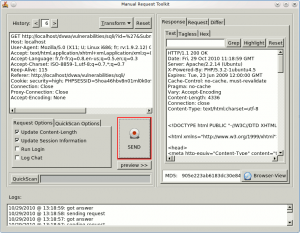Watobo/Interface
Global view
Menu
- File:
- New/Open: Create a new project / open an existing project
- Exit: Quit the application
- Recent Sessions: Show list of last sessions
- Settings
- Forwarding proxy: Enables to parameterize eventual proxy settings
- Session Management: Show list of login script, session IDs and logout signature
- Create Certificate: Enable to create a certificate
- Target Scope:
- Scanner Settings: Parameters of the active scan
- Interceptor Settings: Parameters of the interceptor (port, filters, ...)
- Tools
- Transcoder: Transcoder for various hashes (URL, MD5, Hex, MD5, SHA-1)
- Interceptor: Interceptor window
- View
- Logs: Show logs window
- Dashboard: Display dashboard
- Chat-Table: Display list of chats
- Help
- About: Show credits
Icons
Settings
Forwarding proxy
|
This screen enables to configure a proxy. You must specify:
|
Session Management
The session management window is composed of 3 tabs:
|
|
|
|
|
Create Certificate
|
This module enables to create a certificate. Fill in following fields:
It generates the *.pem files in the plugins/CA/ directory |
Target Scope
|
This screen enables to define the target scope among all detected sites during a passive scan. By clicking on the "edit..." button on the right of each target, it is possible to:
These settings will mainly impact the active scan. |
Scanner Settings
|
This screen enables to define the scanner settings:
|
Interceptor Settings
|
This screen enables to parameterize the interceptor behavior:
|
Findings/Sites
|
Findings: This list is fed by both passive and active scans. It shows, for each scanned site:
Sites: This list is also fed by scans, but organizes pages with a treeview corresponding to the one on the server. |
Views
Chat table
Doc filter
This filter applies on the chat records. It enables to hide pictures, documents, javascripts and stylesheets from the view.
Text filter
This filter applies on chat records. It enables to isolate a unique or a group of specific records with a text string. It is possible to specify if the string applies to requests and/or responses.
Options
|
This enables to define options that apply to the list of chats:
|
Chat table
This show the list of conversations (chats).

This menu is accessible from any line of the chat table. It applies on the selected line and shows following options:
- Send To
- Fuzzer: sends selected chat to Fuzzer
- Manual Request: sends selected chat to Manual Request
- Exclude from Scan
- Chat (#): Chat identification number to exclude from the scan.
- Copy
- URL: Copies the entire selected URL with parameters (e.g. http://localhost/foo/bar/index.php?p1=1&p2=2)
- Site: Only copies the domain name (e.g. localhost)
- Add to Login-Script: Selected chat will be added to the Login-Scripts list (see Session management).
Request/Response
|
By clicking on a chat, it automatically refreshes both the request and the response of the server in the right panel. Both contents are grepable, wich offers a nice search feature. Hex display is also available, as well as a tagless view (tag isolation) for the response tab. On top of this panel, you can access the Browser View, the Fuzzer and Manual Request modules. |
Dashboard
|
The dashboard is composed of 2 tabs:
|
Logs
|
This view shows the logs generated by passive and active scans. |
Tools
Browser View
|
The browser view enables to send the content of a request in the browser. It is accessible from the manual request window or from the request/response panel. |
Fuzzer
|
The fuzzer enables to probe various payloads and get the responses from the server. The fuzzer is very valuable thanks to the complete set of payloads: list of values, counter, regular expressions, self-defined functions, filters... The fuzzer module is accessible from the request/response panel and from the contextual menu (Send to>Fuzzer). The structure is as follows: tag > generator > action. You first define tag(s), associate a generator (file, counter, list) and eventual post-actions (Encode Base-64, Encode URL, Hash-MD5 or Ruby Procedure). Right click on an element to choose appropriate action from the contextual menu. For more information on how to use this module, please refer to the fuzzing example. |
Manual Request
Main window

This module enables to transform an existing request and to send it to the server.
Options
- Request Options
- Update Content-Length: Automatically corrects Content-Length following transformations made on the request
- Update Session Information: Enables to update the sessions (useful to keep session cookie updated from one request to another for not having to login each time)
- Run Login: Plays request identified in the Login Script (see Session Management)
- Log Chat: Logs transformed requests/responses in the events list
- QuickScan Options
- Use Original Request
- Log Scan
Buttons:
- History: Navigate through chats IDs
- Transform: Switches GET and POST
- Reset: Cancels eventual transformations and displays original request
- Send: Sends transformed request to the server
- Preview: Sends transformations to the request window on the right
- QuickScan: Opens up the vulnerabilities window to quick scan them.
The Manual Request module is accessible from the request/response panel or from the contextual menu (Send To>Manual Request)
Differ tab
Once you have transformed requests and sent it to the server via the Manual Request module, you can compare the results by selecting the "Differ" tab and by clicking on the "Diff it" button.
For more information on how to use differ, refer to this section.
Transcoder
|
The Transcoder module enables to encode/decode a string in various hashes:
|
Interceptor
|
Before anything, Watobo is a proxy that enables to intercept/modify requests and responses. To catch the content, activate the window from the menu (Tools>Interceptor). Commands: Requests/Responses checkboxes enable to precise the content to intercepted/displayed
|






























